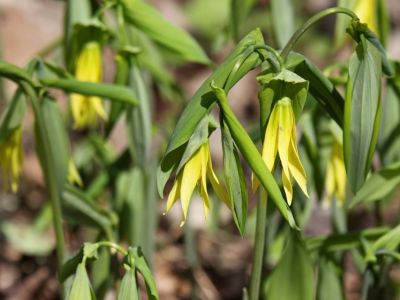Bellwort Wildflowers
There are five species in this genus, Uvularia. This family of plants is named after the flower’s resemblance to the uvula as well as the curative powers the herb possesses for throat ailments. Merry bells is another name for this cheery little woodland herb. The native plants are part of a temperate understory forest ecosystem. Bellwort plants get up to 24 inches (61 cm.) tall and spread 18 inches (46 cm.) wide. The carpet of foliage is born on slender rangy stems and may be lance-like, oval, or even heart-shaped. Springtime, around April to June, brings about the interesting flowers that hang in bell-shaped butter yellow groups. The dangling blooms are about 1 inch (2.5 cm.) long and yield a three-chambered fruit.
Where to Grow Bellworts
There are several cultivars available to the home gardener from nurseries and online garden centers. All varieties require part to full shade in soils that are organically rich and moist. Spaces that have been allowed to retain a good tree canopy or temperate moist regions, such as the Pacific Northwest, provide excellent areas as for where to grow bellworts. Bellwort wildflowers are hardy to USDA plant hardiness zones 4 to 9. Provide them with shelter from the full rays of the sun and plenty of moisture and you will have the sunny flowers for years to come.
Growing Bellwort Plants
The best way to start bellwort plants is from division. Do not go out into the woods and harvest the plants. Again, they are readily available from nurseries. Seed starting is persnickety at best. The germination rate is not optimal and the plant requires conditional cues from the environment to sprout. Growing bellwort from divided roots or separating stolens is a proven method for starting new plants. Simply dig up the plant in late winter to early spring and cut it into two sections. The plant naturally multiplies itself from the stolens or sprouting stems it sends out from the base plant. This is much like strawberries, and it is easy to separate rooted stolens and create a new clump of the wildflower.
Care of Bellwort
Bellwort needs rich moist soil but it cannot be boggy. Ensure the area you are planting drains well. Work in generous amounts of organic compost or leaf litter to a depth of at least 6 inches (15 cm.). Choose areas under plants or thickly populated shrubby spaces where protection from hot sun can be found. Mulch around the plants in colder zones in fall. The foliage dies back and rises again in spring, so no pruning or trimming is necessary. Watch for slug and snail damage and excess moisture. Other than that, these little woodland herbs are a perfect match for the natural forest garden.
